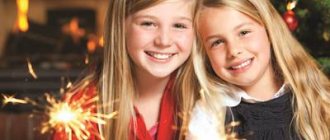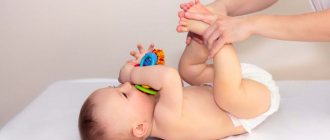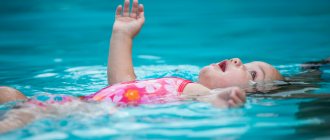Many parents wonder how to develop a child at 2 months. There are also those who consider any activity a waste of time, because the baby is still too small to understand anything. However, the degree of his development greatly depends on how often and fruitfully his relatives communicate with him.
Baby
At two months, the child already sees better, which means he can distinguish objects, and he is especially good at recognizing the faces of adults who often come into contact with him. Do not neglect classes, because children's abilities directly depend on the interest of adults.
What to do with a 2 month old baby
Playing with the baby 2 months ago was meaningless, because he could not yet perceive the world around him either with the help of sight or with the help of hearing. However, now he perfectly understands where the sound is coming from, and even turns towards the source, this is one of the first important skills. Its second new ability is facial recognition. Therefore, the simplest and most useful game for a 2-month-old baby is “peek-a-boo,” when one of the parents or other persons known to the child hides behind their palms or another opaque barrier, and then appears, accompanying the event with the exclamation “peek-a-boo!” .
Peek-a-boo game
The answer to the important question of how to develop a 2-month-old child at home is very simple and concise - you need to communicate with the child. Even when the grandfather does not know what to say or what to do with the baby, it is important to give each family member the opportunity to communicate with the child, as best they can. The baby can already easily recognize the mother’s voice and timbre, but this is what development is all about: getting acquainted with new sounds, new faces and sensations.
The second month of a child’s life is famous for the appearance of one of the most pleasant skills for all family members - a smile. Now, if you smile broadly at your baby, he will smile back. You can make grimaces or make funny sounds - all this will now make the baby smile.
A set of exercises for a child up to 2 months
Every child’s morning should begin with exercise. If he wakes up and requires food, the newborn is fed, the food is allowed to digest for 40 minutes, after which exercises begin. It consists of kneading the joints:
- The child is placed on his back, a finger is placed in his palms and, after waiting for the grasping reflex, they raise their hands to his head. Do these exercises five to seven times.
- Thoroughly knead your hands. To do this, you need to bend each hand separately, either inward or outward, and then make circular movements with an open hand or fist, without putting much effort on the child’s joint.
- Kneading of the knees is carried out to a position that does not cause discomfort to the child. After normal flexion/extension of the joint, the legs are alternately pressed against the stomach in a bent position.
- Gently stretch the ankle in a circular motion, without struggling with the child’s resistance.
- Using baby cream, massage your feet, feeling each joint at the base of your toes.
- Be sure to massage your child’s belly in a strictly clockwise direction half an hour before meals.
- Placing your baby on his stomach before eating will help expel air from the esophagus, reducing the likelihood of spitting up after eating.
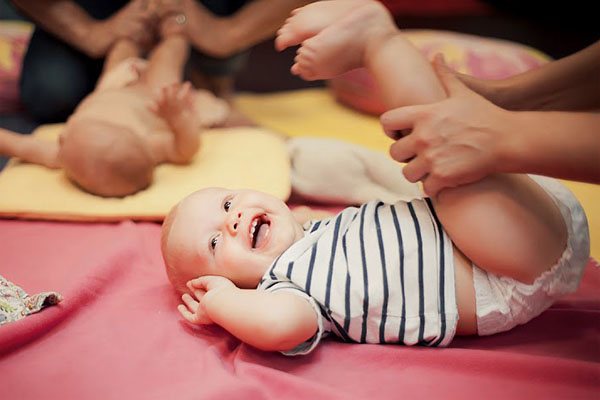
Charger
Games for a two month old baby
Games for babies will help develop tactile skills, expand knowledge of the world and learn basic colors. Every game should bring joy to the child. If at the moment the baby does not like some kind of game, do not insist, it is better to postpone the idea for a while. The best instruments for playing will be toys that rustle and ring, but they need to be of good quality so that they do not make too annoying sounds and do not have sharp corners or holes for pinching fingers.
It is important to understand! It is difficult for a baby to hold even the lightest and smallest rattle tightly; his coordination of movements is still imperfect. Therefore, the child will often let the object slip out of his hands or periodically accidentally hit himself in the face with it. Because plastic rattles can cause physical pain, it is better to choose fabric stuffed rattles for this age, which will protect the skin from accidental bruises and tears.
Physical development
Gymnastics for a 1 month old baby is necessary for his physical development and well-being. It includes simple exercises - carefully bending the arms and legs, lifting the baby by the arms, after placing your fingers in his palms so that he can hold himself.
Already at this age, a child can be taught to hold his head. To acquire this skill, it is recommended to periodically lay it on your stomach. The time for such an exercise should be limited. As soon as you see that the child is tired, turn him over to his usual position.
Gentle stroking of the back, arms and legs is also useful. To prevent your baby from suffering from colic, it is recommended to lightly massage his tummy in a clockwise circular motion.
It is better to perform exercises and massage 30 minutes before feeding, on a full stomach and before bedtime, physical impact is undesirable. The optimal duration of classes is 2-4 minutes.
Approximate daily routine at 2 months
When the baby is 2 months old, he already has a certain daily routine. If the child is fed by the hour, and not on demand, then by this age you can easily plan 2-hour walks in the air, without fear of hungry and capricious crying. He can stay awake for 2-2.5 hours. The child will sleep often, but not as long as before. Most often, breastfed children experience the following regimen:
- eating;
- sleep lasting 30 minutes or more;
- wakefulness from 2 to 2.5 hours;
- at night, the interval between feedings often increases to 6 hours.
Formula-fed babies may feel fuller longer, so the intervals between feedings may increase by up to 4 hours during the day.
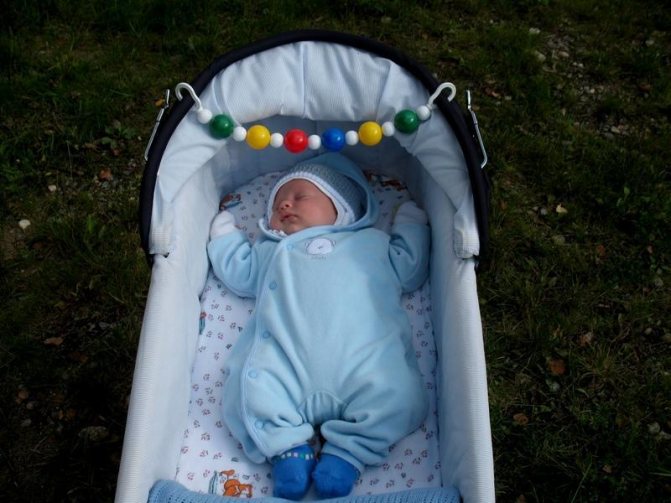
Sleeps in a stroller
Additional Information. In the fresh air, children sleep much sounder and longer, despite the noise of the street. Therefore, young mothers, wanting to wander along the paths with a stroller for a longer time, adhere to the following rule: they feed the child, immediately get him ready for a walk, where he falls asleep in a very short time. Staying in the fresh air in this case can last up to 3 hours.
Development of a child’s motor activity
To develop physical activity, in addition to daily exercise, it is useful to use bathing. Well-known practicing pediatrician Komarovsky E.O. recommends such bathing from the moment the umbilical wound has healed, that is, practically from the first days of life. As you know, it is easier to make any movements in water than on land. So, a baby immersed in water can try to sit and even stand without harm to health. The most beneficial bathing for a child is complete freedom of movement, when only the head remains above the water, and the whole body, bypassing the force of gravity, easily moves in different directions. A special neck-mounted swimming ring or the caring hands of parents are perfect for such bathing.
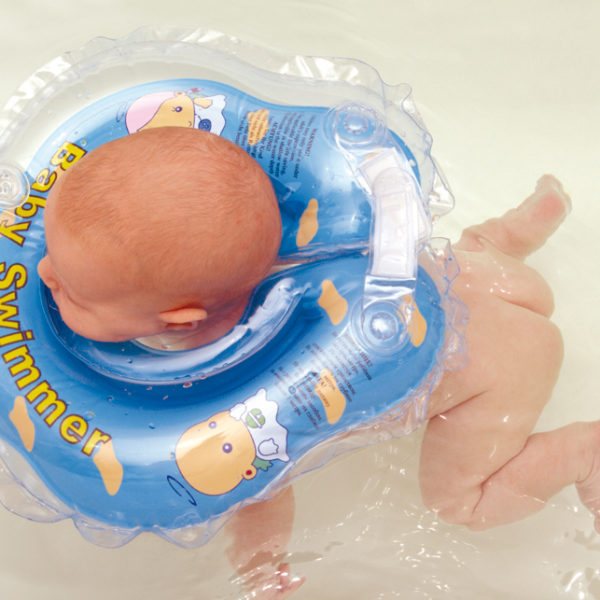
Swimming circle
In the daytime, an hour and a half after feeding, exercise on a large inflatable ball (fitball) will be useful. It does an excellent job of developing the muscles of the back and neck. The exercise is as follows:
- cover the ball with a clean diaper;
- place the child on the ball, constantly holding him by the legs;
- swing back and forth, allowing the baby to first touch the floor with his arms and then with his legs;
- with a small amplitude, make circular rolling movements with the ball, massaging the stomach.
The first year of a child’s life practicing on such a ball will be very useful and will allow the muscular skeleton to be prepared for the subsequent vertical position of the body.
Communicative development of a child at 2 months of life
It is very important that not only mother participates in the game. It will be interesting for the child to watch the facial expressions of his grandparents, because the mother’s usual timbre of voice is so different from others. Classes with your grandfather can be very interesting if he has a mustache or beard. Engaging your child in touching the scalp will not only be useful, but also extremely enjoyable. How a grandfather should play with a two-month-old child, he will decide for himself, remembering his youth.
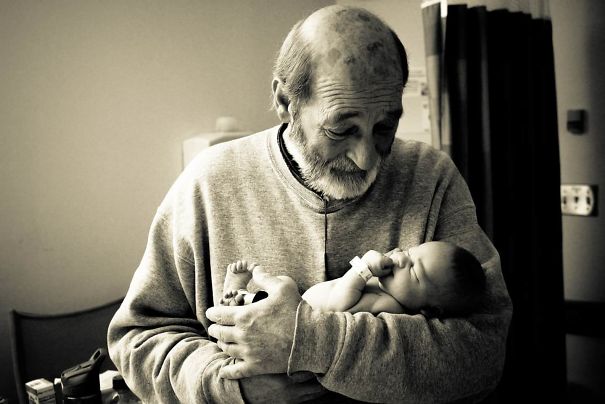
Baby and grandfather
Activities with a 2 month old baby to develop attention
The most successful activity in the house with a child is to play to develop attentiveness. To do this, a bright object or the face of a relative is hidden behind an opaque fabric and always appears in different parts of it: sometimes from the edge, sometimes in the central part of the fabric, but from the other edge, sometimes from below. The baby, busy monitoring the appearance of a hidden target, will try to guess the location of its subsequent appearance.
How to develop visual perception at 2 months
In order to develop a child’s vision, it is best to use bright objects. At this age, it is important to choose colors without halftones. The ideal choices are red, yellow, blue and green. It is better not to use shades such as turquoise, blue, pink in educational games for now.
The correct game is for the child to follow the slow movement of a bright object. There is no need to carry the toy further than a meter. First, show it right in front of your face, at a distance of about 50 cm. Then slowly move it to the right, then again in the center, then to the left. Such eye gymnastics will help develop the eye muscles, strengthening them.
Games and toys for children aged 2 months that develop hearing
Toys that can develop a child’s hearing should not be too loud so that their use does not frighten the baby. High-quality mobiles that attach to the crib will not only help develop your hearing with their melodious, pleasant music, but also give your mother enough free time so that she can do her own business. Many contain a whole program of different melodies that help both develop and calm down before bed.
Attention! You should attach the mobile to the crib in strict accordance with the detailed instructions, without neglecting safety precautions.
Educational mats with arcs for hanging toys perfectly develop not only hearing, but also other senses. The child can reach any object hanging above him. Most often, each element has its own separate function: some rustle, others vibrate, others ring. This is done in order to teach the baby to distinguish an object not only by color, but also by sound in its entirety. By remembering what sound each toy makes, your baby will soon be able to choose his favorite.
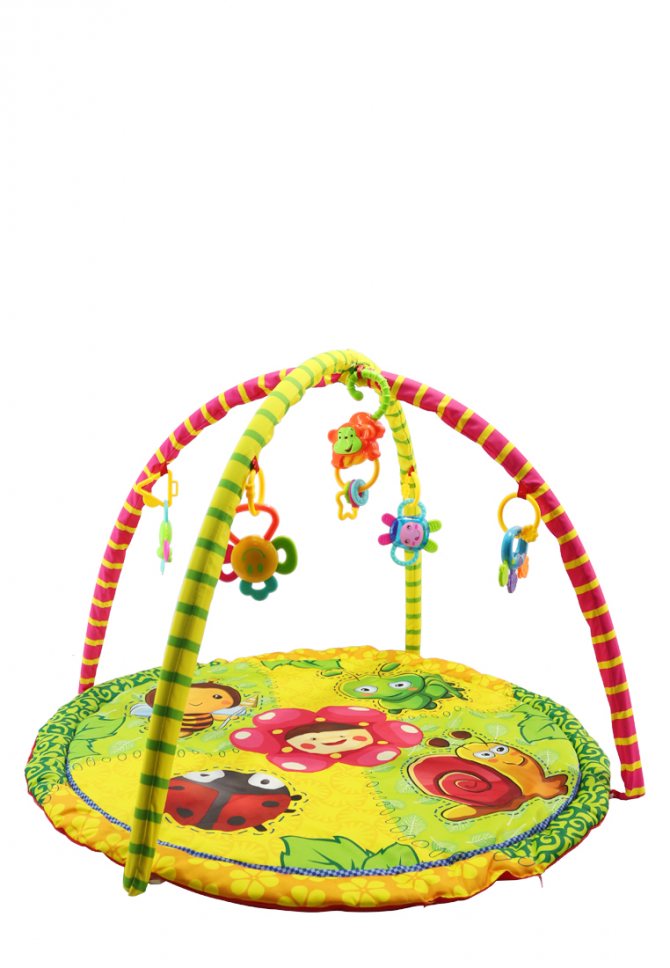
Developmental mat
Educational games should not tire the baby. You can keep your child occupied with an exciting, but still challenging game for no longer than a couple of minutes. He will certainly communicate his fatigue by crying. During the first few years, a child should be taught in a playful way, without causing negative emotions.
Consultation “What to do with a child at home”
Anna Smirnova
Consultation “What to do with a child at home”
Sometimes you have to stay at home with your child for several days in a row: either a high temperature, or chickenpox, or the weather is completely unflyable, or the mother herself is sick and there is simply no one to walk with the baby outside, or some other misfortune or natural anomaly. You never know what situations there are! But this is not a reason to be sad at all! Our ideas on how to entertain children at home will help you .
At home with a child 3-6 years old, you can find a lot of ways to spend time not boring, if there is no need to severely limit his activity:
- throw a disco,
- jump into the hopscotch, "drawn"
tape on the floor
- play hide and seek,
- organize an impromptu fashion show, etc.
If running and jumping is undesirable, choose quieter entertainment:
- arrange a light show using a regular flashlight,
- build a hammock or house under the table,
- read a book so you can dramatize it later, etc.
These ways to entertain your child at home don’t cost a lot of money and won’t take up much of your time. But such attention and love will not go unnoticed by the child . These are exactly those childhood experiences that become more and more valuable with age.
Joint games for parents and children bring invaluable benefits in the formation of children's character and in the development of the psyche. Games allow parents to pass on their life experience to their children, teach them to be independent, not to be afraid to make important decisions, to bear responsibility for them and to correctly evaluate the actions of others. In addition, spending time together improves the relationship between parents and children.
It is very important for adults to organize the game correctly and to interest children in it as much as possible. To do this, it’s good to immediately take the role of an ordinary participant and, remembering your childhood, completely immerse yourself in the game. A child , noticing such sincere parental interest, will certainly be carried away by the process.
Games for children should primarily be aimed at developing:
memory;
attentiveness and speed of reaction;
communication skills;
physical endurance and agility.
Educational games
The most common and simple educational games for children are the following:
"Cold - hot"
.
The child selects an object or favorite toy, hands it to an adult, closes his eyes or turns away (the main thing is not to peek)
.
An adult hides an object in the room. Then the child gradually approaches certain objects in the room in search of a hidden toy. At this time, the adult gives him hints: “cold”
,
“warmer”
or
“hot”
.
If the child moves in the wrong direction, the prompt “cold”
.
If the search direction is correct, then, respectively, “warm”
,
“warmer”
and
“hot”
.
"What's missing?"
.
In this game, an adult places various objects on the table in front of the child : pencils, pens, counting sticks, small toys, and so on. Then he asks the child to close his eyes , while he himself removes something from the table. When the child opens his eyes , the adult asks him to name the missing object. This game can be slightly transformed and place unambiguous but multi-colored objects on the table (for example, pencils, and also ask the child to determine what color the pencil has disappeared.
“Male and female names”
.
According to the rules of the game, an adult and a child must take turns quickly calling out male and female names.
However, no name should be repeated. "Tasty - tasteless"
.
It is advisable that there be several children's participants in this fun game. You will also need a medium-sized ball. The adult takes turns throwing the ball to the children, while naming something edible or inedible. If something edible is heard, the child must catch the ball, and if it is inedible, push it away from him.
“Draw the same way”
.
An adult draws several simple geometric shapes on a piece of paper (triangle, square, circle, rectangle), shows it to the child for 1 minute , then removes the piece of paper and asks the child to draw on a blank piece of paper what he just saw, and in the same sequence.
Communicative games
Communication games help a team of children and adults make friends faster, find a common language, and learn to understand each other perfectly . Among these games, the most useful are:
"Let's get acquainted!"
. Children and adults sit in a circle mixed together. The very first participant says his name. Then the second participant also says his name, but also adds his age. The third one follows the same pattern, but adds the place of his residence or study to the story about himself. And the very last participant, closing the circle, should already have a whole coherent story about himself.
"Smart Engine"
. Participants in the game need to organize a kind of line, standing one after another and placing their hands on the shoulders of the person in front. The adult usually stands up first. Then the guide begins to show some movement. The line standing behind him should exactly repeat them.
"Fun Geography"
. Children and adults sit in a circle. Then everyone takes turns saying their name, country or city starting with the same letter as their name.
Sport games
Sports games with parents, which develop physical endurance, dexterity and coordination of movements, are also very important. Moderate physical activity is very beneficial for a growing body. Sports games contribute to the development of correct posture, develop all muscle groups, and strengthen the child’s . The advantage of such games is that they do not require special equipment, so you can play them at home :
"The fastest"
.
Usually two players play, an adult and a child .
They take two chairs, to the backs of which they tie a wide ribbon. Then, on command, everyone begins to twist their own ribbon. The one who does it faster and sits on the chair first will win. For coordination of movements. Usually two people participate. Both simultaneously grab the right ear with their right hand and the nose with their left hand. Then you need to clap your hands and change hands, i.e., take your left ear with your left hand, and your nose with your right hand. The winner is the one who has not violated the rules of the game even once and has not gotten confused .
"The Blind Artist"
. Several children and several adults participate. First, children draw each adult with their eyes closed. Then adults draw children with their eyes closed. At the end, everyone opens their eyes and looks at what they did.
All games where children and parents play as equals are not only a fun way to spend time together, but a way to increase children's self-esteem. Thanks to such games, children feel their importance and equality with adults, which allows them to fully develop spiritually and physically. A harmoniously developed child , who will eventually turn into a self-sufficient adult, confidently and firmly walking through life, is the dream of every parent!




